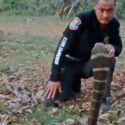First, they gain your trust. Then, they promise you a better life somewhere else. Suddenly, you’re in a foreign country and you don’t speak the language. When they take away your passport and every penny you earn, you’re their captive.
Human trafficking includes the recruitment, harboring, and controlling of the movement of a person by using force, coercion and deception, with the intent to exploit them for labor or sexual services.
According to the International Labour Organization, in 2016, over 40 million people were victims of human trafficking. And it affects victims of various genders, ages and nationalities. Almost anyone could fall into the trap of a human trafficker.
Could you be a victim of human trafficking without knowing it? How could you escape? And what signs could help you identify a victim?
Step 1. Watch for red flags
Every trafficking case is different, and you could be trafficked without knowing it. You might be in a human trafficking situation if someone promised you a better life or a relationship, then took you to work in another country. Also, traffickers might not pay you, or pay very little but force you to work many hours. Or you could be forced into sexual activities.
Joy was taken to the UK when she was 12 years old, supposedly to help her aunt and go to school. But instead, she was put to work for long hours in the house. Three years later, the aunt took Joy to work for a friend of hers. But the woman slapped Joy whenever she did something wrong, and the husband abused her. Joy eventually found support through a charity and left the house.
Step 2. Listen to survivors
Malaika Oringo survived human trafficking. Her story began at age15, in Kampala, Uganda. After her mother died, she was looking for relatives to support her. A man dressed as an aid worker approached her. He was a white European. After earning her trust, he promised to help her go to school. But when they arrived in Luxembourg, he handed her over to people who took her to Amsterdam. She was exploited for a year, until she became ill. But instead of seeking medical attention for Malaika, the traffickers dumped her by a road. Fortunately, she was found and taken to a safe house for minors.
Malaika believes that giving survivors a voice and the chance to help form policies is the way to eradicate human trafficking. So she founded Footprint to Freedom, a survivor-led organization that focuses on leading victims out of exploitation.
Step 3. Don’t believe the myths
Human trafficking takes many forms, and sex trafficking is only one of them. Another is forced labor. These illegal activities are often called modern slavery, as they involve exploitation. There are many myths about this issue, and getting rid of misconceptions could help you identify a dangerous situation. You might believe that human trafficking only happens in low and lower-middle-income countries. But the truth is that it exists in every country, including wealthy ones. And it can happen anywhere, from big cities to suburbs or rural areas, even in your community.
Step 4. Advocate
Unfortunately, human trafficking is a lucrative business. The United Nations estimates that this criminal activity brings its perpetrators about $32 billion per year. But it might be possible to limit it by driving down the demand. You could start by trying to be a voice for the victims of trafficking. Spread the word. Talk to your family, friends and neighbors, and inform them about this global issue. You can also donate and support organizations that help victims of human trafficking.
Step 5. Educate yourself
Contrary to what you’ve seen in movies, all human trafficking victims are not kept behind locked doors, in basements or chained. Many of them are in plain view. But since many people are not aware of, or don’t understand the signs of human trafficking, you could have interacted with a victim without realizing it. But how do human traffickers control and manipulate their victims? Their tactics including emotionally abusing their victims, threatening them, using violence, and keeping their victims isolated. And traffickers often take control of their victims’ identification documents and money.
You may have seen signs of human trafficking if you realize someone cannot access their travel or ID documents, or they disappear without reason.
Step 6. Look for signs
You can continue to educate yourself about human trafficking and look for signs that someone in your community is a victim of it. There are some explicit signs to look out for. Be aware of tattooing or branding symbols, especially names, on the person.
If you find out the person was reported as missing, that is a red flag, especially if the person is secretive about their activities and never shares anything about their family or partner even though they have told you they are in a relationship.
Even after surviving this horrible situation, you’ll likely be traumatized by the experience for years to come. You may find it hard to trust people. Or you might find yourself looking over your shoulder in paranoia. But wait, that hooded man does seem like he’s been following you for a while now. Maybe you’re not paranoid after all.
Sources
- “What Is Human Trafficking?”. 2021. justice.gc.ca.
- “The Victims”. 2014. National Human Trafficking Hotline.
- “Global Estimates Of Modern Slavery: Forced Labour And Forced Marriage“. 2017. ilo.org.
- “The Protocol For Human Trafficking”. 2021. United Nations : Office On Drugs And Crime.
- “Myths and Misconceptions”. dhs.gov



























